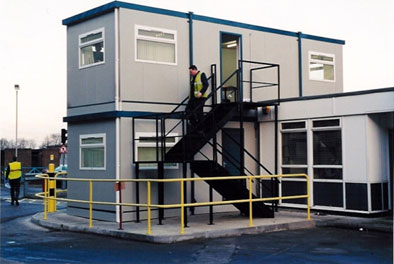Site office
Construction sites will generally require office facilities to provide accommodation for site managers, provide space for meetings and to provide storage for site documentation. Site offices are often described as ‘site huts’ even if they are large and well fitted out.
It is important that site offices are comfortable, attractive and versatile, as well as being suitably robust and secure. Regulation 17 of the Construction (Design and Management) Regulations 2015 (the CDM Regulations) states:
‘A construction site must, so far as is reasonably practicable, have sufficient working space and be arranged so that it is suitable for any person who is working or who is likely to work there, taking account of any necessary work equipment likely to be used there.’
Each individual project will have different requirements for site office provision. On large projects separate offices may be provided for site foremen, engineers and the commercial and project management team.
As site offices are generally temporary in nature, only there for the duration of the construction works, they are often prefabricated, or constructed from portable, or modular, buildings, frequently referred to as ‘portacabins’ (although 'Portkabin®' with a 'k' is a trade marked brand name of Portakabin Limited). These are standard sizes and can be fitted together or stacked to form almost any configuration of accommodation required. They can include reception spaces, offices, meeting rooms, kitchens, toilets, showers, changing facilities, lockers, storage, and so on.
Site offices are easily transported on flat-bed trucks and set up on site using a crane. Typically they have four adjustable steel legs with attachments for stacking. Site office panelling is usually made of galvanised steel sheet and a rigid insulation core. A plasterboard inner lining is used for walls and ceiling. Windows are often designed to optimise light levels, with white walls and heavy-duty flooring that is easy to clean. Several manufacturers provide anti-vandal protection, such as pyro-shield windows with steel shutters and high-security steel doors.
They are often stacked with external metal stairs leading to the second floor. Large sites may have several inter-linked portable offices capable of holding hundreds of people, stacked up to three-storeys high with internal stairs and steel frame bracing.
They may be purchased or rented, and once construction is complete, either returned or take to a new site for re-use.
[edit] Related articles on Designing Buildings Wiki
- Lighting of construction sites.
- Main construction compound.
- Materials on site.
- Mobilisation.
- Off site materials.
- Office.
- Office definition.
- Office manual.
- Office space planning.
- Pre construction information.
- Site layout plan.
- Site facilities.
- Site storage.
- Temporary site services.
- Welfare facilities.
- Workplace definition.
[edit] External references
- ‘Building Construction Handbook’ (6th ed.), CHUDLEY, R., GREENO, R., Butterworth-Heinemann (2007)
Featured articles and news
Latest Build UK Building Safety Regime explainer published
Key elements in one short, now updated document.
UKGBC launch the UK Climate Resilience Roadmap
First guidance of its kind on direct climate impacts for the built environment and how it can adapt.
CLC Health, Safety and Wellbeing Strategy 2025
Launched by the Minister for Industry to look at fatalities on site, improving mental health and other issues.
One of the most impressive Victorian architects. Book review.
Common Assessment Standard now with building safety
New CAS update now includes mandatory building safety questions.
RTPI leader to become new CIOB Chief Executive Officer
Dr Victoria Hills MRTPI, FICE to take over after Caroline Gumble’s departure.
Social and affordable housing, a long term plan for delivery
The “Delivering a Decade of Renewal for Social and Affordable Housing” strategy sets out future path.
A change to adoptive architecture
Effects of global weather warming on architectural detailing, material choice and human interaction.
The proposed publicly owned and backed subsidiary of Homes England, to facilitate new homes.
How big is the problem and what can we do to mitigate the effects?
Overheating guidance and tools for building designers
A number of cool guides to help with the heat.
The UK's Modern Industrial Strategy: A 10 year plan
Previous consultation criticism, current key elements and general support with some persisting reservations.
Building Safety Regulator reforms
New roles, new staff and a new fast track service pave the way for a single construction regulator.
Architectural Technologist CPDs and Communications
CIAT CPD… and how you can do it!
Cooling centres and cool spaces
Managing extreme heat in cities by directing the public to places for heat stress relief and water sources.
Winter gardens: A brief history and warm variations
Extending the season with glass in different forms and terms.
Restoring Great Yarmouth's Winter Gardens
Transforming one of the least sustainable constructions imaginable.























